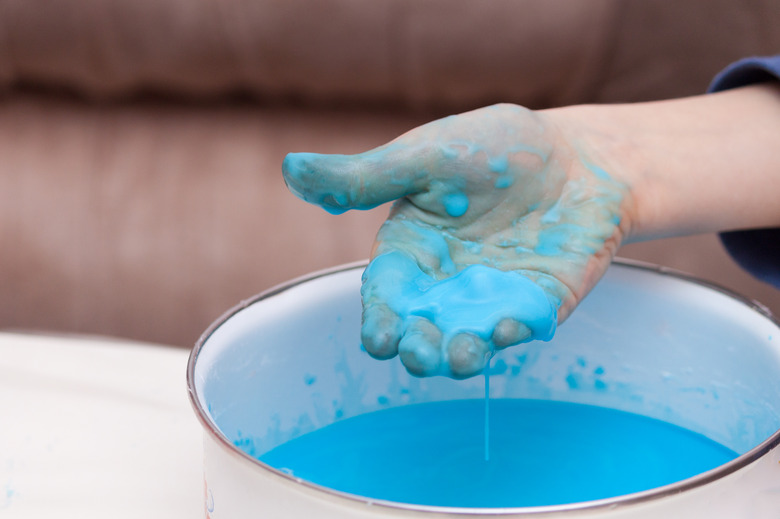Experiments With Cornstarch & Water
Matter is usually defined as being a solid, a liquid or a gas. Suspensions, however, act as different states of matter depending on the force applied to them. Using cornstarch and water, you can create a suspension and conduct experiments to model how this type of matter behaves.
Suspensions
Suspensions
Mix 1 cup of cornstarch and 1 cup of water in a bowl. Stir until you have the consistency of pancake batter. Put your hands in the mixture and move them around. The more you try to move it, the thicker and more solid it feels. Pour the mixture into a pan and hit it with an open hand. It doesn't splash. Cornstarch and water creates a suspension. When squeezed, it feels like a solid because its molecules move closer together, lining up. It looks and acts like a liquid when there is no force applied to it because the molecules are relaxed and separated.
Cornstarch Quicksand
Cornstarch Quicksand
Demonstrate how quicksand works by mixing 1 cup of water to a box of cornstarch. Place your hand into the mixture and move it around. The more you move, the more solid it becomes. Try to grab the mixture and pull it upward. The sensation is the same sensation you would feel in quicksand. Place an object in the mixture, then try to remove it. Cornstarch and water make a suspension; a mixture of two substances where one is dispersed into the other. In this case, cornstarch is dispersed into water. Quicksand is a mixture of sand and water, where the grains of sand float on the water. The faster you move around in it, the harder it becomes to get out, just as with the cornstarch and water.
Non-Newtonian Fluid
Non-Newtonian Fluid
Non-Newtonian fluids turn into solids when pressure is applied. To demonstrate this, mix a quarter-cup of cornstarch with a quarter cup of water. Try to pick up the mixture in your hand and work it into a ball on your palm. It is solid and workable if you push it around. When you stop, it turns to liquid. Tap it with your finger, then press your finger slowly into the mixture. When you move slowly you allow the cornstarch molecules to separate. When you tap it, the cornstarch molecules move closer together and cannot slide past each other, creating a barrier. In most fluids, viscosity is only affected by temperature. These are called Newtonian fluids. Cornstarch and water is affected by temperature as well, but its level of viscosity also depends on the force applied to it or how fast something moves through it. This makes it non-Newtonian. Quicksand and ketchup are also non-Newtonian fluids.
Dancing Suspensions
Dancing Suspensions
Cornstarch and water does not have a constant viscosity. Left alone, it looks like a liquid. When stressed, such as when you push it or pull it, it changes to a solid. Demonstrate this by doing an experiment with speakers. Mix a box of cornstarch with a cup of water. Find an old speaker and remove the bottom part (the woofer) and hook it up to an amplifier. Line the speaker with a plastic bag and pour the cornstarch into it. Turn the speaker on at about 20 hertz, with the volume at a medium level. At 20 hertz the speaker's percussive movements disturb the mixture enough to make it move. The sound waves travel through to make the mixture appear to dance in finger-like formations.
Cite This Article
MLA
Miller, Renee. "Experiments With Cornstarch & Water" sciencing.com, https://www.sciencing.com/experiments-cornstarch-water-8294087/. 25 April 2011.
APA
Miller, Renee. (2011, April 25). Experiments With Cornstarch & Water. sciencing.com. Retrieved from https://www.sciencing.com/experiments-cornstarch-water-8294087/
Chicago
Miller, Renee. Experiments With Cornstarch & Water last modified March 24, 2022. https://www.sciencing.com/experiments-cornstarch-water-8294087/
